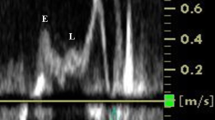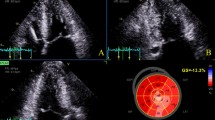Abstract
In this study, we investigated whether early systolic lengthening (ESL) which reflects subclinical ischemia and other echocardiographic and clinic parameters predict primary outcome [appropriate ICD shock, cardiovascular mortality and ventricular tachycardia (VT) or fibrillation] in patients with hypertrophic cardiomyopathy (HCM). 202 Patients with HCM (68% male, mean age 48 ± 13.9 years) were included in the study. Patients’ clinical, electrocardiographic, 2D classic and speckle tracking echocardiography (STE) data were collected. ESL was defined as time from onset of the Q wave on ECG (onset of the R wave if the Q wave was absent) to maximum myocardial systolic lengthening. Patients were divided into two groups as occurrence or absence of primary outcome during 5 years follow up. During the follow-up period of 5 years (mean follow-up duration, 45.9 ± 10.8 months), 31 patients (15%) developed primary outcome [appropriate ICD shock 22 (11%), cardiovascular death 6 (3%), VT/VF 3(1.5%)]. Higher HCM Risk SCD score, longer ESL, and decreased global longitudinal peak strain (GLPS) were observed in patients with primary outcome. A Cox regression analysis, ESL, GLPS and HCM Risk SCD score were found to be independent predictors of occurrence of primary outcome. In ROC curve analysis, ESL > 53.5 msn could discriminate between groups with and without a primary outcome (AUC 0.768, 80% sensitivity and 60% specificity, CI 95% 0.666–0.871). ESL were found to be predictive for primary outcome in patients with HCM. Readily measurable ESL could be helpful to distinguish patients at high risk who could optimally benefit from ICD therapy.




Similar content being viewed by others
Data availability
Our data are not publicly available to preserve participants’ anonymity. Interested parties are invited to contact the authors to discuss the analysis.
Consent for publication
All of authors have declared consent for publication.
References
Kofflard MJM, Ten Cate FJ, van der Lee C, van Domburg RT (2003) Hypertrophic cardiomyopathy in a large community-based population: clinical outcome and identification of risk factors for sudden cardiac death and clinical deterioration. J Am Coll Cardiol 41:987–993. https://doi.org/10.1016/s0735-1097(02)03004-8
Decker JA, Rossano JW, Smith EO et al (2009) Risk factors and mode of death in isolated hypertrophic cardiomyopathy in children. J Am Coll Cardiol 54:250–254. https://doi.org/10.1016/j.jacc.2009.03.051
Cardim N, Galderisi M, Edvardsen T et al (2015) Role of multimodality cardiac imaging in the management of patients with hypertrophic cardiomyopathy: an expert consensus of the European Association of Cardiovascular Imaging Endorsed by the Saudi Heart Association. Eur Heart J Cardiovasc Imaging 16:280. https://doi.org/10.1093/ehjci/jeu291
Elliott PM, Anastasakis A, Borger MA et al (2014) 2014 ESC Guidelines on diagnosis and management of hypertrophic cardiomyopathy: the Task Force for the Diagnosis and Management of Hypertrophic Cardiomyopathy of the European Society of Cardiology (ESC). Eur Heart J 35:2733–2779. https://doi.org/10.1093/eurheartj/ehu284
O’Mahony C, Jichi F, Pavlou M et al (2014) A novel clinical risk prediction model for sudden cardiac death in hypertrophic cardiomyopathy (HCM risk-SCD). Eur Heart J 35:2010–2020. https://doi.org/10.1093/eurheartj/eht439
Buja G, Miorelli M, Turrini P et al (1993) Comparison of QT dispersion in hypertrophic cardiomyopathy between patients with and without ventricular arrhythmias and sudden death. Am J Cardiol 72:973–976. https://doi.org/10.1016/0002-9149(93)91118-2
D’Andrea A, Caso P, Severino S et al (2006) Prognostic value of intra-left ventricular electromechanical asynchrony in patients with hypertrophic cardiomyopathy. Eur Heart J 27:1311–1318. https://doi.org/10.1093/eurheartj/ehi688
Adabag AS, Maron BJ, Appelbaum E et al (2008) Occurrence and frequency of arrhythmias in hypertrophic cardiomyopathy in relation to delayed enhancement on cardiovascular magnetic resonance. J Am Coll Cardiol 51:1369–1374. https://doi.org/10.1016/j.jacc.2007.11.071
Maurer MS, Bokhari S, Damy T et al (2019) Expert consensus recommendations for the suspicion and diagnosis of transthyretin cardiac amyloidosis. Circ Heart Fail 12:e006075. https://doi.org/10.1161/CIRCHEARTFAILURE.119.006075
Lyseggen E, Vartdal T, Remme EW et al (2009) A novel echocardiographic marker of end systole in the ischemic left ventricle: “tug of war” sign. Am J Physiol Heart Circ Physiol 296:H645–H654. https://doi.org/10.1152/ajpheart.00313.2008
Bijnens B, Claus P, Weidemann F et al (2007) Investigating cardiac function using motion and deformation analysis in the setting of coronary artery disease. Circulation 116:2453–2464. https://doi.org/10.1161/CIRCULATIONAHA.106.684357
Brainin P, Biering-Sørensen SR, Møgelvang R et al (2020) Duration of early systolic lengthening: prognostic potential in the general population. Eur Heart J Cardiovasc Imaging 21:1283–1290. https://doi.org/10.1093/ehjci/jez262
Smedsrud MK, Sarvari S, Haugaa KH et al (2012) Duration of myocardial early systolic lengthening predicts the presence of significant coronary artery disease. J Am Coll Cardiol 60:1086–1093. https://doi.org/10.1016/j.jacc.2012.06.022
Kühlkamp V, Dörnberger V, Mewis C et al (1999) Clinical experience with the new detection algorithms for atrial fibrillation of a defibrillator with dual chamber sensing and pacing. J Cardiovasc Electrophysiol 10:905–915. https://doi.org/10.1111/j.1540-8167.1999.tb01261.x
Higgins SL, Lee RS, Kramer RL (1995) Stability: an ICD detection criterion for discriminating atrial fibrillation from ventricular tachycardia. J Cardiovasc Electrophysiol 6:1081–1088. https://doi.org/10.1111/j.1540-8167.1995.tb00385.x
Lang RM, Badano LP, Mor-Avi V et al (2015) Recommendations for cardiac chamber quantification by echocardiography in adults: an update from the American Society of Echocardiography and the European Association of Cardiovascular Imaging. Eur Heart J Cardiovasc Imaging 16:233–270. https://doi.org/10.1093/ehjci/jev014
Schabelman S, Schiller NB, Silverman NH, Ports TA (1981) Left atrial volume estimation by two-dimensional echocardiography. Catheter Cardiovasc Diagn 7:165–178. https://doi.org/10.1002/ccd.1810070206
Pepi M, Tamborini G, Galli C et al (1994) A new formula for echo-Doppler estimation of right ventricular systolic pressure. J Am Soc Echocardiogr Off Publ Am Soc Echocardiogr 7:20–26. https://doi.org/10.1016/s0894-7317(14)80414-8
Brainin P, Biering-Sørensen T, Jensen MT et al (2020) Prognostic value of early systolic lengthening by strain imaging in type 2 diabetes. J Am Soc Echocardiogr. https://doi.org/10.1016/j.echo.2020.09.008
Minamisawa M, Koyama J, Kozuka A et al (2018) Duration of myocardial early systolic lengthening for diagnosis of coronary artery disease. Open Heart 5:1–9. https://doi.org/10.1136/openhrt-2018-000896
Kahyaoglu M, Gecmen C, Candan O et al (2019) The duration of early systolic lengthening may predict ischemia from scar tissue in patients with chronic coronary total occlusion lesions. Int J Cardiovasc Imaging 35:1823–1829. https://doi.org/10.1007/s10554-019-01624-7
Zahid W, Eek CH, Remme EW et al (2014) Early systolic lengthening may identify minimal myocardial damage in patients with non-ST-elevation acute coronary syndrome. Eur Heart J Cardiovasc Imaging 15:1152–1160. https://doi.org/10.1093/ehjci/jeu101
Brainin P, Haahr-Pedersen S, Olsen FJ et al (2020) Early systolic lengthening in patients with ST-segment–elevation myocardial infarction: a novel predictor of cardiovascular events. J Am Heart Assoc. https://doi.org/10.1161/JAHA.119.013835
Saumarez RC, Camm AJ, Panagos A et al (1992) Ventricular fibrillation in hypertrophic cardiomyopathy is associated with increased fractionation of paced right ventricular electrograms. Circulation 86:467–474. https://doi.org/10.1161/01.cir.86.2.467
Funabashi N, Takaoka H, Horie S et al (2013) Regional peak longitudinal-strain by 2D speckle-tracking TTE provides useful information to distinguish fibrotic from non-fibrotic lesions in LV myocardium on cardiac MR in hypertrophic cardiomyopathy. Int J Cardiol 168:4520–4523
Hartlage GR, Kim JH, Strickland PT et al (2015) The prognostic value of standardized reference values for speckle-tracking global longitudinal strain in hypertrophic cardiomyopathy. Int J Cardiovasc Imaging 31:557–565. https://doi.org/10.1007/s10554-015-0590-5
Reant P, Mirabel M, Lloyd G et al (2016) Global longitudinal strain is associated with heart failure outcomes in hypertrophic cardiomyopathy. Heart (Br Card Soc) 102:741–747. https://doi.org/10.1136/heartjnl-2015-308576
De S, Borowski AG, Wang H et al (2011) Subclinical echocardiographic abnormalities in phenotype-negative carriers of myosin-binding protein C3 gene mutation for hypertrophic cardiomyopathy. Am Heart J 162:262-267.e3. https://doi.org/10.1016/j.ahj.2011.05.018
Ozawa K, Funabashi N, Takaoka H, Kobayashi Y (2017) Successful MACE risk stratification in hypertrophic cardiomyopathy patients using different 2D speckle-tracking TTE approaches. Int J Cardiol 228:1015–1021. https://doi.org/10.1016/j.ijcard.2016.11.141
Debonnaire P, Thijssen J, Leong DP, Joyce E (2014) Global longitudinal strain and left atrial volume index improve prediction of appropriate implantable cardioverter defibrillator therapy in hypertrophic cardiomyopathy patients. Int J Cardiovasc Imaging. https://doi.org/10.1007/s10554-014-0378-z
Liu H, Pozios I, Haileselassie B et al (2017) Role of global longitudinal strain in predicting outcomes in hypertrophic cardiomyopathy. Am J Cardiol 120:670–675. https://doi.org/10.1016/j.amjcard.2017.05.039
Maron BJ (2010) Contemporary insights and strategies for risk stratification and prevention of sudden death in hypertrophic cardiomyopathy. Circulation 121:445–456. https://doi.org/10.1161/CIRCULATIONAHA.109.878579
Acknowledgements
We thank all the patients who voluntarily participated in the study.
Funding
The author(s) received no financial support for the research, authorship, and/or publication of this article.
Author information
Authors and Affiliations
Corresponding author
Ethics declarations
Conflict of interest
All of the authors have no conflict of interest.
Ethical approval
Ethical approval was obtained from the Ethics Committee of Kartal Kosuyolu Heart Training and Research Hospital in Istanbul (Turkey).
Informed consent
Each participant provided written informed consent after receiving a detailed description of the study.
Additional information
Publisher's Note
Springer Nature remains neutral with regard to jurisdictional claims in published maps and institutional affiliations.
Rights and permissions
About this article
Cite this article
Candan, O., Gecmen, C., Kahyaoğlu, M. et al. Myocardial early systolic lengthening predicts mid-term outcomes in patients with hypertrophic cardiomyopathy. Int J Cardiovasc Imaging 38, 161–168 (2022). https://doi.org/10.1007/s10554-021-02484-w
Received:
Accepted:
Published:
Issue Date:
DOI: https://doi.org/10.1007/s10554-021-02484-w




